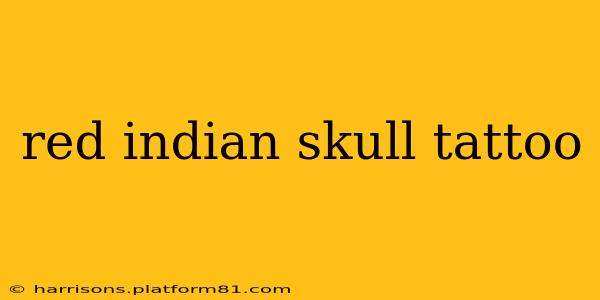The red Indian skull tattoo, often depicting a Native American warrior's skull adorned with feathers or other tribal elements, holds deep symbolic meaning for many. It's a powerful image that transcends mere aesthetics, representing a complex interplay of strength, resilience, heritage, and even spirituality. This design choice is not without its controversies, however, and requires careful consideration before committing to permanent ink. Let's delve into the nuances of this striking tattoo style.
What does a red Indian skull tattoo symbolize?
The symbolism inherent in a red Indian skull tattoo varies depending on the specific design elements included. However, some common interpretations include:
-
Strength and resilience: The skull itself often represents the enduring strength of the spirit, the ability to overcome adversity, and perseverance in the face of hardship. This resonates deeply with the historical struggles and resilience of Native American communities.
-
Ancestral heritage: For many, the tattoo serves as a powerful connection to their Native American ancestry, a visual representation of their heritage and cultural pride. It can be a way to honor ancestors and maintain a link to their traditions.
-
Spirituality and connection to nature: Native American cultures often hold profound spiritual beliefs connected to nature. A skull tattoo, especially one incorporating natural elements like feathers or animals, might symbolize a connection to the spirit world or the natural cycles of life and death.
-
Respect and remembrance: It's crucial to note that for some, the skull may represent a specific ancestor or figure of historical significance within their community. The tattoo serves as a tribute and a way to keep their memory alive.
Is it culturally appropriate to get a red Indian skull tattoo?
This is a crucial question that demands careful consideration. The appropriation of Native American imagery and symbols by those outside of the culture has a long and painful history. It’s vital to approach this tattoo design with respect and sensitivity:
-
Research and understanding: Before getting a red Indian skull tattoo, thoroughly research the cultural significance of the imagery you choose. Understand the history and meaning behind the symbols to avoid perpetuating harmful stereotypes.
-
Consult with Native American artists: If possible, consult with Native American artists or members of relevant tribes. Their insight and guidance can be invaluable in ensuring your tattoo is respectful and appropriately represented. Their input can help avoid unintentional cultural misrepresentation.
-
Consider the potential for misinterpretation: Be mindful that even with careful research, your tattoo may be misunderstood or misconstrued by others. Be prepared to explain its significance and address potential concerns with sensitivity and respect.
What are some common design elements in red Indian skull tattoos?
The design possibilities are numerous, but common elements include:
-
Feathers: Represent freedom, spirituality, and connection to nature. Different feather types and arrangements carry specific cultural meanings within different Native American tribes.
-
Tribal patterns: Incorporate traditional geometric designs unique to various tribes, adding layers of cultural significance.
-
Animals: Represent different aspects of nature and spirituality, such as strength (bear), wisdom (owl), or swiftness (eagle).
-
War paint: Can add a striking visual element, but again, research is vital to avoid misrepresentation of specific tribal styles.
How much does a red Indian skull tattoo cost?
The cost of a red Indian skull tattoo varies significantly depending on factors such as the size, complexity, detail, and the artist's experience and location. Small, simple designs might cost a few hundred dollars, while larger, highly detailed pieces can cost thousands.
What are some alternatives to a red Indian skull tattoo?
If you're drawn to the symbolism of strength and resilience but have concerns about the cultural appropriateness of a red Indian skull tattoo, consider alternative designs. These could include tattoos that celebrate nature, spirituality, or personal journeys of strength, without directly employing potentially problematic imagery.
Ultimately, the decision to get a red Indian skull tattoo is a personal one. However, it’s imperative to approach this decision with respect, awareness, and a deep understanding of the cultural heritage it represents. Thorough research, consultation, and careful consideration are crucial to ensure your tattoo is a meaningful and respectful tribute, not a form of cultural appropriation.
